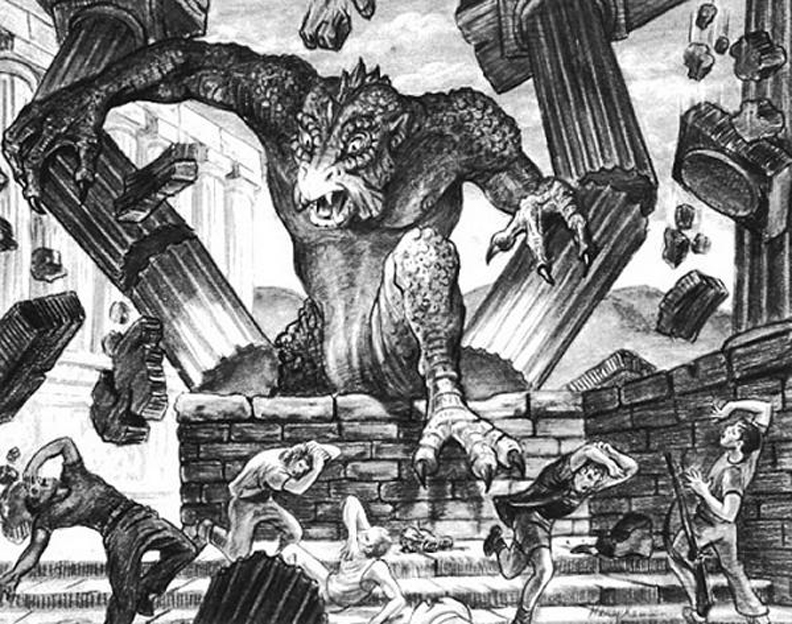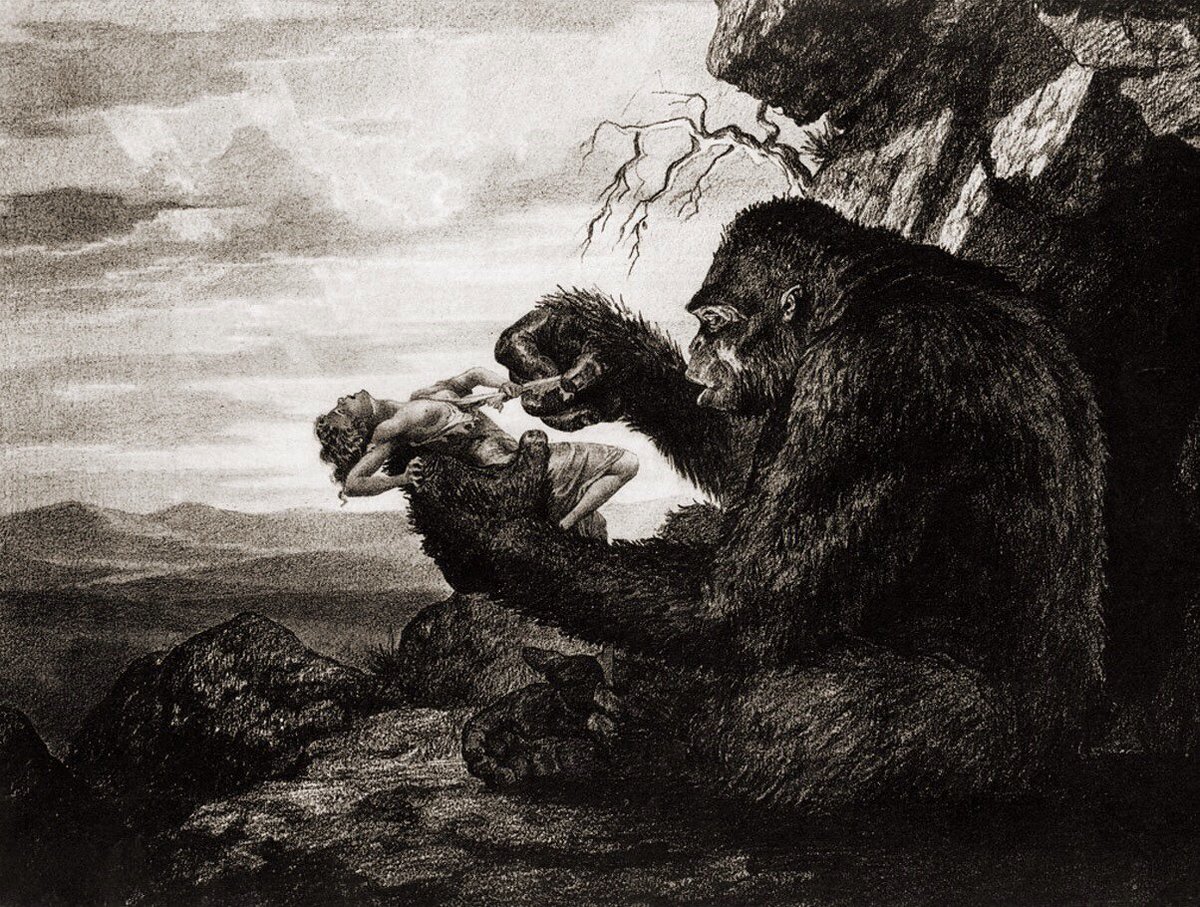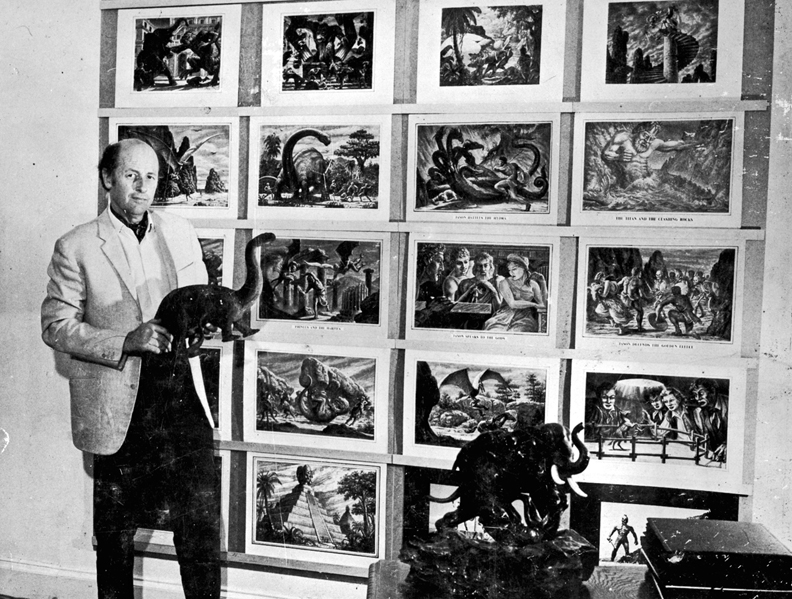by Arnie Fenner
Special effects wizard Ray Harryhausen passed away on May 7 at the age of 92. I was a fan of Ray’s at an early age, thanks to repeated viewings of Earth vs. the Flying Saucers, The 7th Voyage of Sinbad, and Jason and the Argonauts on Saturday afternoon TV. But I had never seen any of his films in a theater (or in color) until my mom dropped me off at the Aztec in 1967 to see One Million Years BC. I was going on 13 and starting to pay attention to girls, so Raquel Welch in her fur bikini was a serious draw for me (I had a 6′ poster of her tacked up on the back of my bedroom door)…almost (not quite, but almost) as much as the promise of dinosaurs animated by Harryhausen.
My feeling after leaving the theater was (if I recall correctly) that I wished there had been less material to Raquel’s bikini and more dinosaurs by Ray.
Today, even with all of the brilliant and seamless SFX work in films created by armies of great artists and designers, it is surprisingly easy to explain why Ray Harryhausen means so much to my generation. Yes, without exception all of the films he worked on were simple B-Movie entertainments intended for younger audiences: bare-bones plots, casts made up of character actors rather than stars, scripts with little (if any) memorable dialogue, all wrapped around a handful of scenes that featured [1] a monster tearing something up or [2] a monster fighting with a monster or [3] guys fighting the monster. There were no ambiguous endings, no real deep messages (well, other than that setting off A-Bombs was bad news), no blood, and no sex (beyond Raquel’s revealing attire, of course—it
was a
Hammer production after all).
Speaking of sex: Byron Crabbe’s concept drawing for the original King Kong.
Forry Ackerman used to loan Ray stills and copies of production art from Kong to study
and I can see Crabbe’s influence on Harryhausen’s drawing style.
None of that mattered for one simple reason:
Ray Harryhausen was one of
us. An artist and a fan, he infused a sense of both craft and care into his work at a time when there was little of either evident in science fiction and fantasy movies of the day. He created in an era of small budgets, short schedules, and limited understanding of or appreciation for what he was accomplishing with stop-motion. Though many have a fondness for the men-in-monster-suits movies of the 1950s and ’60s, we all knew that what Harryhausen was doing was something else entirely, something magical. He loved the genre and worked in it his entire life.
Mike Presley, a member of Don Punchatz’s Sketchpad Studio, drew this great cover
for the 1970s fanzine devoted to Harryhausen’s work.
Championed in the pages of Famous Monsters of Filmland, Photon, Cinenfantastique, and even a fanzine devoted to his work, FXRH, we got to know a lot about Ray through the years. And one of the things I enjoyed the most was the opportunity to see many of the concept drawings he’d produce when planning his films which were often included with this or that article. What they lacked in polish or technique, they made up for with unbridled energy: as a kid I was originally bowled over by the ideas on display, by the concepts that he would eventually bring to life on the screen. Years later, I find them incredibly charming and better understand their appeal for me in my youth. In many ways their execution reminds me of what me and my friends were drawing in middle and high school: pages filled with energetic scenes, excitedly rendered to the point of ridiculous obsession in pencil. Ah, those were the days. Ray, of course, was an adult when he did his drawings, but they exhibit his perpetually youthful enthusiasm for the fantastic.

The Ymir for 20 Million Miles to Earth
The 7th Voyage of Sinbad
The cyclops for The 7th Voyage of Sinbad
More cyclops shenanigans for Sinbad
Jason and the Argonauts
An unrealized adaptation of The War of the Worlds
For The Valley of Gwangi
The Golden Voyage of Sinbad
Clash of the Titans
After he retired from film making in 1981, Harryhausen turned to sculpting and making bronze statues. It’s obvious from this wonderful piece of Kong fighting the T-Rex that he never lost his passion for the movie that first inspired his career.



Thanks for posting these. It was a good way to start my Monday morning. Ray will be missed.
He was never a grandmaster was he Arnie? My childhood would have been a lot different without him. Maybe I would have been an accountant. You probably should post a warning about the cyclop guys. A little racy for a Monday morning.
I have come to accept that it's over now – but Harryhausen prolonged my childhood way past the usually accepted age. Going to the cinema to see his creations two or three times in a row, just for the goosebumps caused by the almost unbearable tension of waiting for his creations to come stomping and roaring onto the screen.
Grandmaster indeed.
Regarding the Grand Master Award: no, he never received it. There was some serious consideration/debate one year among the board members, but it was argued that the film/entertainment industry already has multiple high-profile ways to recognize achievement and, as an Oscar-winner and repeated subject of film-festivals et al, Harryhausen had already been significantly honored. Working exclusively in the movie biz (particularly when you're the one with a huge producer credit) isn't quite the same as doing book covers, comic pages, or gallery work.
Re: the cyclops guys. Ha! I'll never be able to look at that drawing quite the same way again!
I dare say Im quite a bit younger than you Arnie, but my love for Harryhausen's work seems no less passionate. My hope is that the next generation will be able to look upon these films with the same awe and admiration, and that great men and women will be able live on forever as a result of their stunning work. I know when the time comes, my plan is help this by showing my kids these works, among many other greats of the past.